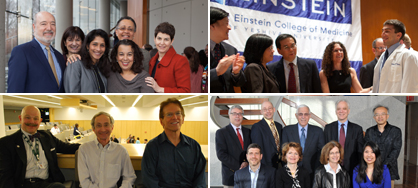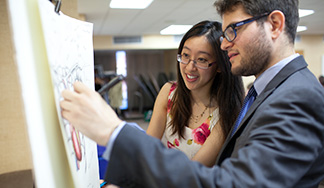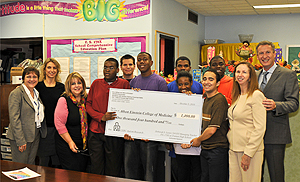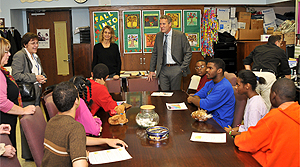

A Special Gift for Einstein's CERC
P.S. 176X Students Give Support to Autism Research and Care
Einstein’s Children’s Evaluation and Rehabilitation Center, or CERC, was the first organization that came to mind for Nadine McNeil — whose son, Tyler, is diagnosed with autism and attends P.S. 176X, the largest school for children with autism in New York City. Tyler and his classmates had raised $1,400 through activities they had coordinated and were trying to figure out where to donate the money.

Students, teachers and staff from P.S. 176X present their donation of $1,400 to Drs. John Foxe (far right) and Sophie Molholm (second from left)The medical school’s nationally renowned center serves children with intellectual and other disorders, including those with autism spectrum disorders (ASD).
“I thought of CERC because it has always served my son so well,” said Mrs. McNeil.
In 1992, when she began to observe changes in her son’s behavior, Mrs. McNeil was rebuffed by doctors at several hospitals who claimed Tyler was demonstrating typical male-toddler tendencies. It was only when she went to CERC that her concerns were taken seriously.
She recalled, “They said ‘We understand. We’re seeing something and we’ll take a closer look.’ CERC is where I found the help that I needed.”
Ever since those first visits, Tyler has participated in a variety of CERC’s treatment programs. Over time, Mrs. McNeil noticed that “every time I took Tyler to the Kennedy Center [where some CERC offices are located], I would see students from P.S. 176.”
Ultimately, the decision of where to donate the funds they raised was the students’ to make, according to Deborah Laster, a multimedia teacher at the school. So, it was the students who determined that they would like to channel their funds to autism research and treatment being done at CERC — a decision whole-heartedly supported by the school’s principal Rima Ritholtz.
When Dr. John Foxe, director of research at CERC, heard about the students’ fundraiser for the center he was struck with a sense of awe and admiration. “It really touched me,” he said. “These students are a special group of people. They did it all themselves without us approaching them. It’s such a wonderful gift that they’ve given us.”
CERC’s research team is one of ten such teams that constitute the center’s programs. Through these teams, the center has 60,000 patient contacts per year while serving some 7,000 children who have been diagnosed with a variety of developmental and other disorders, ranging from ASD to cerebral palsy and HIV/AIDS.
“What makes the program so distinctive and successful is its interdisciplinary, team-based approach,” said CERC’s director, Dr. Robert Marion. “Each of our teams is composed of a group of interdisciplinary professionals — development behavioral pediatricians, social workers, psychologists, neurologists, physical and occupational therapists, among many others — all of whom work together to evaluate the children and to make recommendations regarding therapy.”
Of the students’ gift he noted, “This represents one of an ongoing series of efforts to promote community outreach and activism at CERC. The gift is particularly special because of the connection between our center and the students. And it’s our hope that this special connection will lay the foundation for future projects between CERC and P.S. 176.”

Drs. Molholm and Foxe visit with P.S. 176X students and learn about their art projects.CERC’s director of community affairs, Joanne Siegel, who worked closely with the school in coordinating the presentation of the gift, agreed: “It was very rewarding to learn that the students wanted to give the funds they raised to support our research and treatment of autism. It’s such a meaningful form of ‘thank you’ and could help lead to providing further services while also improving our understanding of autism spectrum disorders.”
To raise the funds the students employed graphic design skills that they have learned with help from Mrs. Laster. Several years ago, struck by the strides she observed among students, she developed the idea for a fundraising activity that would allow the students to use their newfound skills. They began by creating computer-generated candy bar wrappers, designed by the students to be tailored to specific events.
The program, named “It’s a Wrap,” has expanded significantly as Mrs. Laster is often approached by individuals hosting wedding and engagement parties, bar mitzvahs and other events — each wanting the students’ unique product and touch.
Other students at the school contribute to the production process, helping to prepare and put together the wrapping for the candy bars. Still others take part in another popular fundraising endeavor, known as “We’re Notable,” through which students use graphic design and manual skills to create school calendars and cards with special imagery.
“While these programs help to raise money for autism research and awareness, they also serve as examples of our school’s emphasis on providing students with social skills that can help them to lead engaged, integrated lives,” said Mrs. Laster. “Once our students get to the high school level, we try to gear everything towards offering some sort of vocational training and empowering them to make choices for themselves.”
As an example she noted how Tyler has been encouraged to pursue his considerable athletic skills. As a swimmer he has competed on the state level in the Special Olympics and, as a runner he has trained with the Achilles International Track Club. Running with the club’s guides, he recently completed his third New York City Marathon. In addition to his athletic pursuits, he is a volunteer to local businesses.
The school’s fundraising activities are an extension of this philosophy of empowerment. “Everything is their choice,” explained Mrs. Laster. “When it comes to any of the jobs and tasks, they have the choice of which one they would like to do and the input on where they want the money to go.”
She continued, “The benefit of these activities is two-fold. As the students are very connected to their fundraising efforts they also gain greater self awareness of themselves as individuals. These two things go hand in hand.”
While the students and Mrs. Laster were thrilled to present the money from their fundraising efforts to help promote autism research and treatment at CERC, it was Dr. Foxe and his colleague Dr. Sophie Molholm who derived an added benefit from making a trip to P.S. 176X to collect the students’ check. Dr. Foxe observed, “Mrs. Laster is a special teacher. I just feel like the world could use more teachers like Mrs. Laster and these kinds of kids.”
Posted on: Friday, November 12, 2010


